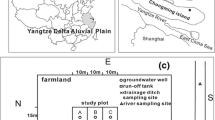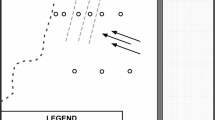Abstract
Losses of dissolved nutrients (N, P, K, Ca, Mg, Na,Cl, and SO4) in runoff were measured on grasslandand shrubland plots in the Chihuahuan desert ofsouthern New Mexico. Runoff began at a lowerthreshold of rainfall in shrublands than ingrasslands, and the runoff coefficient averaged 18.6%in shrubland plots over a 7-year period. In contrast,grassland plots lost 5.0 to 6.3% of incidentprecipitation in runoff during a 5.5-year period. Nutrient losses from shrubland plots were greater thanfrom grassland plots, with nitrogen losses averaging0.33 kg ha−1 yr−1 vs0.15 kg ha−1 yr−1, respectively, during a 3-year period. Thegreater nutrient losses in shrublands were due tohigher runoff, rather than higher nutrientconcentrations in runoff. In spite of these nutrientlosses in runoff, all plots showed net accumulationsof most elements due to inputs from atmosphericdeposition. Therefore, loss of soil nutrients byhillslope runoff cannot, by itself, account for thedepletion of soil fertility associated withdesertification in the Chihuahuan desert.
Similar content being viewed by others
References
Abrahams AD, Parsons AJ & Wainwright J (1995) Effects of vegetation change on interrill runoff and erosion, Walnut Gulch, southern Arizona. Geomorphology 13: 37–48
Avnimelech Y & McHenry JR (1984) Enrichment of transported sediments with organic carbon, nutrients, and clay. Soil Sci. Soc. Amer. J. 48: 259–266
Bolton SM, Ward TJ & Cole RA (1991) Sediment-related transport of nutrients from southwestern watersheds. J. Irrig. Drain. Eng. 117: 736–747
Bormann FH & Likens GE (1967) Nutrient cycling. Science 155: 424–429
Buffington LC & Herbel CH (1965) Vegetation changes on a semidesert grassland range from 1858 to 1963. Ecol Monogr 35: 139–164
Castillo VM, Martinez-Mena M & Albaladejo J (1997) Runoff and soil loss response to vegetation removal in a semiarid environment. Soil Sci. Soc. Amer. J. 61: 1116–1121
Chorover J, Vitousek PM, Everson DA, Esperanza AM & Turner D (1994) Solution chemistry profiles of mixed conifer forests before and after fire. Biogeochemistry 26: 115–144
D'Elia CF, Steudler PA & Corwin N (1977) Determination of total nitrogen in aqueous samples using persulfate digestion. Limnol. Oceanogr. 22: 760–764
Fisher SG & Grimm NB (1985) Hydrologic and material budgets for a small Sonoran desert watershed during three consecutive cloudburst events. J. Arid. Environ. 9: 105–118
Gifford CG & Busby FE (1973) Loss of particulate organic materials from semiarid watersheds as a result of extreme hydrologic events. Water Resour. Res. 9: 1443–1449
Guilbault MR & Matthias AD (1998) Emissions of N2O from Sonoran desert and effluentirrigated grass ecosystems. J. Arid Environ. 38: 87–98
Gutierrez J & Hernandez II (1996) Runoff and interrill erosion as affected by grass cover in a semi-arid rangeland of northern Mexico. J. Arid Environ. 34: 287–295
Hartley AE (1997) Environmental controls on nitrogen cycling in northern Chihuahuan desert soils. PhD Dissertation, Duke University, Durham NC, U.S.A.
Herbel CE, Gile LH, Fredrickson EL & Gibbens RP (1994) Soil water and soils at soil water sites, Jornada Experimental Range. Soil Survey Investigations Report #44, USDA-Soil Conservation Service, Lincoln, NE, U.S.A.
Hornbeck JW, Martin CW, Pierce RS, Bormann FH, Likens GE & Eaton JS (1986) Clearcutting northern hardwoods: Effects on hydrologic and nutrient ion budgets. Forest Sci. 32: 667–686
Johnson DW, Kelly JM, Swank WT, Cole DW, Van Miegroet H, Hornbeck JW, Pierce RS & Van Lear D (1988) The effects of leaching and whole-tree harvesting on cation budgets of several forests. J. Environ. Qual. 17: 418–424
Kieft, TL,White CS, Loftin SR, Aguilar R, Craig JA & Skaar DA (1998) Temporal dynamics in soil, carbon, and nitrogen resources at a grassland-shrubland ecotone. Ecology 79: 671–683
Lajtha K (1986) The biogeochemistry of phosphorus cycling and phosphorus availability in a desert ecosystem. PhD Dissertation, Duke University, Durham, NC, U.S.A.
Laronne JB & Reid I (1993) Very high rates of bedload sediment transport by ephemeral desert rivers. Nature 366: 148–150
Likens GE, Bormann FH, Pierce RS and Reiners WA (1978) Recovery of a deforested ecosystem. Science 199: 492–496
Likens GE & Bormann FH (1995) Biogeochemistry of a forested ecosystem. 2nd edn. Springer-Verlag, New York
Likens GE, Driscoll CT & Buso DC (1996) Long-term effects of acid rain: Response and recovery of a forest ecosystem. Science 272: 244–246
Marion GM (1989) Correlation between long-term pedogenic CaCO3 formation rate and modern precipitation in deserts of the American Southwest. Quaternary Res. 32: 291–295
Marion GM, Schlesinger WH & Fonteyn PJ (1990) Spatial variability of CaCO3 solubility in a Chihuahuan desert soil. Arid Soil Res. Rehabilitation 4: 181–191
Peterjohn WT, Adams, MB & Gilliam FS (1996) Symptoms of nitrogen saturation in two central Appalachian hardwood forest ecosystems. Biogeochemistry 35: 507–522
Rojas AE (1995) Detailed soil survey of the Jornada LTER (Long term ecological research) transect vicinity, southern New Mexico. MSc Thesis, New Mexico State University, Las Cruces, NM, U.S.A.
Schlesinger WH, Reynolds JF, Cunningham GL, Huenneke LF, Jarrell WM, Virginia RA & Whitford WG (1990) Biological feedbacks in global desertification. Science 247: 1043–1048
Schlesinger WH, Raikes JA, Hartley AE & Cross AF (1996) On the spatial pattern of soil nutrients in desert ecosystems. Ecology 77: 364–374
Schlesinger WH, Abrahams AD, Parsons TJ & Wainwright J (1999) Nutrient losses in runoff from grassland and shrubland habitats in southern New Mexico: I. Rainfall simulation experiments. Biogeochemistry 45: 21–34
Seager WR, Kottlowski FE & Hawley JW (1976) Geology of Dona Ana Mountains, New Mexico. NM Bureau of Mines Mineral Resour Circular 147, Socorro, NM, U.S.A.
Swank WT & Vose JM (1997) Long-term nitrogen dynamics of Coweeta forested watersheds in the southeastern United States of America. Global Biogeochem. Cycles 11: 657–671
Tromble JM (1988) Water budget for creosotebush-infested rangeland. J. Arid Environ. 15: 71–74
Vitousek PM (1977) The regulation of element concentrations in mountain streams in the northeastern United States. Ecol. Monogr. 47: 65–87
Wallace A & Romney EM (1972) Radioecology and ecophysiology of desert plants at the Nevada test site. Environmental Radiation Division, Laboratory of Nuclear Medicine and Radiation Biology, University of California, Los Angeles
Wright RF (1976) The impact of forest fire on the nutrient influxes to small lakes in northeastern Minnesota. Ecology 57: 649–663
Wright RF, Lotse E & Semb A (1994) Experimental acidification of alpine catchments at Sogndal, Norway: Results after 8 years. Water, Air & Soil Pollution 72: 297–315
Author information
Authors and Affiliations
Corresponding author
Rights and permissions
About this article
Cite this article
Schlesinger, W.H., Ward, T. & Anderson, J. Nutrient losses in runoff from grasslandand shrubland habitats in southern New Mexico: II. Field plots. Biogeochemistry 49, 69–86 (2000). https://doi.org/10.1023/A:1006246126915
Issue Date:
DOI: https://doi.org/10.1023/A:1006246126915




